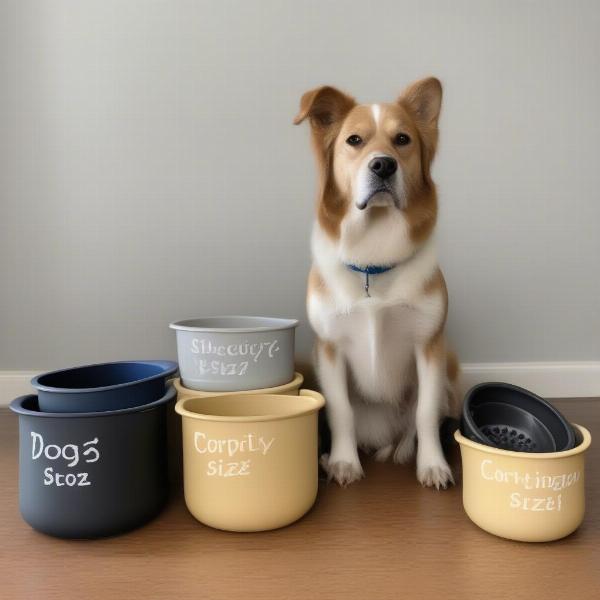Dog crocks are an essential part of every dog owner’s toolkit. But with so many options available, finding the perfect one for your furry friend can feel overwhelming. This guide explores everything you need to know about dog crocks, from materials and sizes to special features and cleaning tips, ensuring your dog has a comfortable and hygienic dining experience.
Material Matters: What are Dog Crocks Made of?
Choosing the right material for your dog’s crock is crucial for their health and well-being. Each material has its pros and cons, and understanding these can help you make the best decision.
- Stainless Steel: Durable, rust-resistant, and easy to clean, stainless steel is a popular choice. It’s also dishwasher-safe, making hygiene a breeze.
- Ceramic: Often featuring fun designs, ceramic crocks are a stylish option. However, they can be prone to chipping and cracking.
- Plastic: Lightweight and inexpensive, plastic crocks are readily available. However, they can be easily chewed or scratched, harboring bacteria.
- Elevated Dog Bowls: Raised bowls can be beneficial for larger breeds or dogs with arthritis, promoting better posture while eating. These often come with stands made of metal, wood, or plastic.
Sizing Up Your Dog’s Crock Needs
Just like humans, dogs need appropriately sized crocks. A small crock for a Great Dane won’t cut it, and a giant bowl for a Chihuahua can be equally problematic. Consider your dog’s breed, size, and eating habits when choosing the right size.
- Small Breeds: Opt for crocks with a capacity of 1-2 cups.
- Medium Breeds: Look for crocks that hold 2-4 cups.
- Large Breeds: Choose larger crocks with a 4-8 cup capacity, or even larger for giant breeds.
 Dog Crocks Size Comparison
Dog Crocks Size Comparison
Special Features for Specific Needs
Beyond material and size, certain features can further enhance your dog’s dining experience.
- Slow Feeders: For dogs who gobble their food, slow feeders can help prevent choking and digestive issues. These bowls have obstacles that force dogs to eat more slowly.
- No-Spill Bowls: If your dog tends to make a mess, no-spill bowls can help contain spills and splashes.
- Travel Bowls: Collapsible or portable bowls are essential for on-the-go adventures.
Keeping Those Crocks Sparkling Clean
Hygiene is paramount when it comes to your dog’s health. Regularly cleaning their crocks is crucial to prevent bacterial growth and illness.
- Daily Cleaning: Rinse your dog’s food and water bowls daily with hot, soapy water.
- Deep Cleaning: At least once a week, give the crocks a thorough scrubbing with a pet-safe disinfectant.
- Dishwasher Safe: If your crocks are dishwasher-safe, take advantage of this convenient cleaning method.
What About Dog Bowls?
While the terms “dog crock” and “dog bowl” are often used interchangeably, some distinguish crocks by their wider, shallower design. Bowls typically have deeper, more upright sides. Ultimately, the best choice depends on your dog’s preferences and eating habits.
Conclusion: The Perfect Crock Awaits
Finding the right dog crocks involves considering your dog’s individual needs. Factors such as size, breed, eating habits, and potential health concerns play a significant role. By taking the time to choose carefully and prioritizing regular cleaning, you can ensure your furry friend enjoys a comfortable and healthy dining experience.
FAQ
- How often should I replace my dog’s crocks? Replace them when they show signs of wear and tear, such as cracks, chips, or deep scratches.
- Can I use human dishes for my dog? While technically possible, dog-specific crocks are designed with their needs in mind, including size and material safety.
- What’s the best way to prevent my dog from tipping over their crock? Consider a weighted or non-slip crock, or a specially designed stand.
- Are elevated dog bowls good for all dogs? While they can be beneficial for some, consult your vet before switching, especially for puppies or dogs with certain medical conditions.
- How can I encourage my dog to use their new crock? Place a small amount of their favorite food in the new crock to entice them.
- What material is best for a dog with allergies? Stainless steel is often recommended for dogs with allergies, as it’s non-porous and less likely to harbor allergens.
- My dog chews on their plastic crock. What should I do? Switch to a more durable material like stainless steel or ceramic.
ILM Dog is your trusted international resource for all things dog-related. We offer expert advice on breed selection, health care, training, nutrition, grooming, and much more. Whether you’re a new dog owner or a seasoned pro, ILM Dog provides the information you need to ensure your canine companion thrives. Contact us for personalized guidance and support: Email: [email protected], Phone: +44 20-3965-8624. Visit us at ILM Dog for a wealth of resources and connect with a global community of dog lovers.